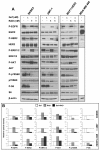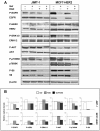The combination of gefitinib and RAD001 inhibits growth of HER2 overexpressing breast cancer cells and tumors irrespective of trastuzumab sensitivity
- PMID: 21961653
- PMCID: PMC3207940
- DOI: 10.1186/1471-2407-11-420
The combination of gefitinib and RAD001 inhibits growth of HER2 overexpressing breast cancer cells and tumors irrespective of trastuzumab sensitivity
Abstract
Background: HER2-positive breast cancers exhibit high rates of innate and acquired resistance to trastuzumab (TZ), a HER2-directed antibody used as a first line treatment for this disease. TZ resistance may in part be mediated by frequent co-expression of EGFR and by sustained activation of the mammalian target of rapamycin (mTOR) pathway. Here, we assessed feasibility of combining the EGFR inhibitor gefitinib and the mTOR inhibitor everolimus (RAD001) for treating HER2 overexpressing breast cancers with different sensitivity to TZ.
Methods: The gefitinib and RAD001 combination was broadly evaluated in TZ sensitive (SKBR3 and MCF7-HER2) and TZ resistant (JIMT-1) breast cancer models. The effects on cell growth were measured in cell based assays using the fixed molar ratio design and the median effect principle. In vivo studies were performed in Rag2M mice bearing established tumors. Analysis of cell cycle, changes in targeted signaling pathways and tumor characteristics were conducted to assess gefitinib and RAD001 interactions.
Results: The gefitinib and RAD001 combination inhibited cell growth in vitro in a synergistic fashion as defined by the Chou and Talalay median effect principle and increased tumor xenograft growth delay. The improvement in therapeutic efficacy by the combination was associated in vitro with cell line dependent increases in cytotoxicity and cytostasis while treatment in vivo promoted cytostasis. The most striking and consistent therapeutic effect of the combination was increased inhibition of the mTOR pathway (in vitro and in vivo) and EGFR signaling in vivo relative to the single drugs.
Conclusions: The gefitinib and RAD001 combination provides effective control over growth of HER2 overexpressing cells and tumors irrespective of the TZ sensitivity status.
Figures






Similar articles
-
Antitumor effect of the mTOR inhibitor everolimus in combination with trastuzumab on human breast cancer stem cells in vitro and in vivo.Tumour Biol. 2012 Oct;33(5):1349-62. doi: 10.1007/s13277-012-0383-6. Epub 2012 Apr 11. Tumour Biol. 2012. PMID: 22492237
-
Phase I/II study of trastuzumab in combination with everolimus (RAD001) in patients with HER2-overexpressing metastatic breast cancer who progressed on trastuzumab-based therapy.J Clin Oncol. 2011 Aug 10;29(23):3126-32. doi: 10.1200/JCO.2010.32.2321. Epub 2011 Jul 5. J Clin Oncol. 2011. PMID: 21730275 Free PMC article. Clinical Trial.
-
Decreased levels of hypoxic cells in gefitinib treated ER+ HER-2 overexpressing MCF-7 breast cancer tumors are associated with hyperactivation of the mTOR pathway: therapeutic implications for combination therapy with rapamycin.Breast Cancer Res Treat. 2007 Dec;106(3):319-31. doi: 10.1007/s10549-007-9502-2. Epub 2007 Mar 9. Breast Cancer Res Treat. 2007. PMID: 17347776
-
Co-targeting estrogen receptor and HER2 pathways in breast cancer.Breast. 2014 Feb;23(1):2-9. doi: 10.1016/j.breast.2013.09.006. Epub 2013 Oct 28. Breast. 2014. PMID: 24176518 Review.
-
Overcoming resistance and restoring sensitivity to HER2-targeted therapies in breast cancer.Ann Oncol. 2012 Dec;23(12):3007-3016. doi: 10.1093/annonc/mds200. Epub 2012 Aug 2. Ann Oncol. 2012. PMID: 22865781 Free PMC article. Review.
Cited by
-
Enhancement by Nano-Diamino-Tetrac of Antiproliferative Action of Gefitinib on Colorectal Cancer Cells: Mediation by EGFR Sialylation and PI3K Activation.Horm Cancer. 2018 Dec;9(6):420-432. doi: 10.1007/s12672-018-0341-x. Epub 2018 Sep 5. Horm Cancer. 2018. PMID: 30187356 Free PMC article.
-
Co-targeting EGFR and IKKβ/NF-κB signalling pathways in head and neck squamous cell carcinoma: a potential novel therapy for head and neck squamous cell cancer.Br J Cancer. 2019 Feb;120(3):306-316. doi: 10.1038/s41416-018-0351-z. Epub 2018 Dec 26. Br J Cancer. 2019. PMID: 30585254 Free PMC article.
-
A cell-to-patient machine learning transfer approach uncovers novel basal-like breast cancer prognostic markers amongst alternative splice variants.BMC Biol. 2021 Apr 12;19(1):70. doi: 10.1186/s12915-021-01002-7. BMC Biol. 2021. PMID: 33845831 Free PMC article.
-
Antitumor effect of the mTOR inhibitor everolimus in combination with trastuzumab on human breast cancer stem cells in vitro and in vivo.Tumour Biol. 2012 Oct;33(5):1349-62. doi: 10.1007/s13277-012-0383-6. Epub 2012 Apr 11. Tumour Biol. 2012. PMID: 22492237
-
Grape polyphenols inhibit Akt/mammalian target of rapamycin signaling and potentiate the effects of gefitinib in breast cancer.Nutr Cancer. 2012;64(7):1058-69. doi: 10.1080/01635581.2012.716898. Nutr Cancer. 2012. PMID: 23061908 Free PMC article.
References
-
- Wiseman SM, Makretsov N, Nielsen TO, Gilks B, Yorida E, Cheang M, Turbin D, Gelmon K, Huntsman DG. Coexpression of the type 1 growth factor receptor family members HER-1, HER-2, and HER-3 has a synergistic negative prognostic effect on breast carcinoma survival. Cancer. 2005;103(9):1770–1777. doi: 10.1002/cncr.20970. - DOI - PubMed
-
- Liang K, Lu Y, Jin W, Ang KK, Milas L, Fan Z. Sensitization of breast cancer cells to radiation by trastuzumab. Mol Cancer Ther. 2003;2(11):1113–1120. - PubMed
Publication types
MeSH terms
Substances
Grants and funding
LinkOut - more resources
Full Text Sources
Other Literature Sources
Medical
Research Materials
Miscellaneous

